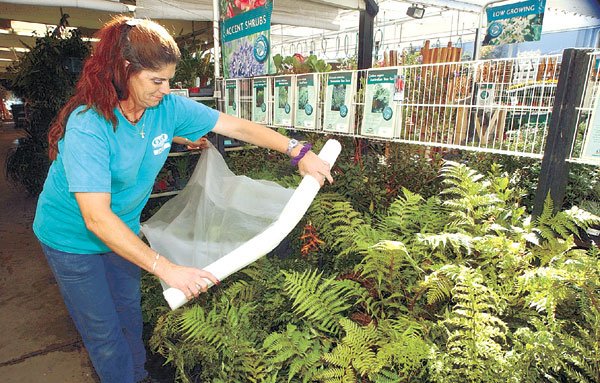The recent chilly nighttime temperatures in the South Valley
serve as evidence that winter is just around the corner. But as the
weeks go on, even lower temperatures will come, and the chill plus
frost can equal disaster in a garden. Flowers, fruits and
vegetables can be rescued from an icy death with a few preventative
measures.
The recent chilly nighttime temperatures in the South Valley serve as evidence that winter is just around the corner. But as the weeks go on, even lower temperatures will come, and the chill plus frost can equal disaster in a garden. Flowers, fruits and vegetables can be rescued from an icy death with a few preventative measures.
“It’s simple, really,” said Judy Bonino, co-owner of LJB Farms in San Martin along with her husband, Louie. “Cover (plants) up or bring them inside.”
Grocery bags and plastic tarps work well as covers, Bonino said, or on sturdier plants, use towels, sheets or canvas. The material adds a layer of protection between the foliage and the frigid air, which is at its chilliest during the early morning, Bonino said.
“Just keep the cold air from hitting them directly,” she said. “There’s a dip in temperature about 15 minutes before dawn when it’s coldest, and that’s when you’re really worried about the plants.”
Plants that are particularly vulnerable to frost include bird of paradise plants, small citrus trees and banana trees, said Jose Pacheco, a gardener at Orchard Supply Hardware in Gilroy. Because those plants are so fragile, they must be covered at night to stay intact, he said.
“Bedding plants, shrubs and bushes may have parts that die off, but they’ll generally just come back in the spring,” he said.
Growers should make sure their plants stay well-watered through the winter, said Sheri Deas, who also works in the garden section of Orchard Supply Hardware in Gilroy. A frost can dry out the soil, depriving plants of water, she said. But it’s important to mind where you’re watering.
“Wet the ground around the plants; don’t wet the plants themselves,” Deas said.
Another way to avoid frosted plants is to watch where you plant them, according to the University of Georgia College of Agricultural and Environmental Sciences. During the winter, the coldest spots on a piece of property are often to the north and northwest, as well as in low areas where cold air can settle. The warmer spots are generally on the southern part of the property.
Additionally, keep in mind that potted plants are especially susceptible to frost because their roots are unprotected. Move potted plants closer to the house at night, as the added protection of a porch or root might help prevent a frost.












